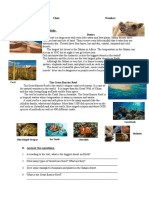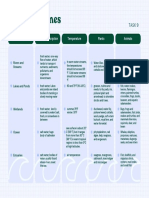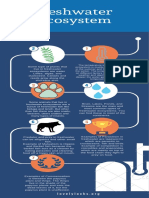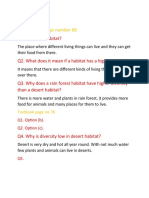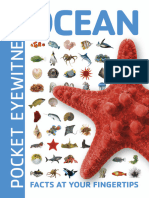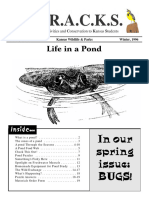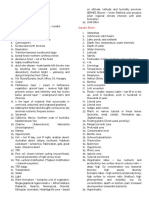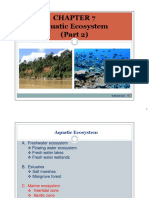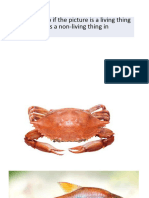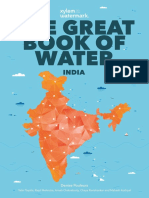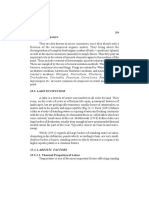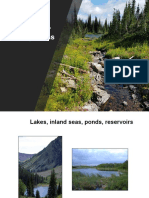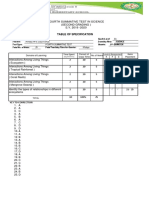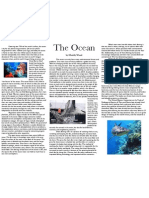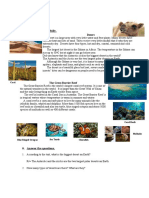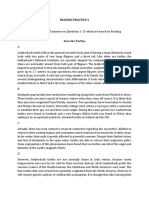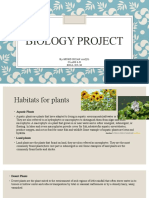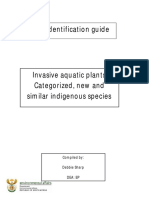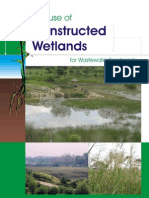Activity 3: Complete The Table Below To Describe The Different Aquatic Biomes of The Earth
Activity 3: Complete The Table Below To Describe The Different Aquatic Biomes of The Earth
Uploaded by
Jaimz Ruiz0 ratings0% found this document useful (0 votes)
52 views2 pagesThe document describes the different aquatic biomes of the Earth. It provides a table that lists 5 aquatic biomes - rivers and streams, lakes and ponds, wetlands, oceans, and estuaries. For each biome, it gives the general description, typical temperature range, common plant life, and animal species found. The biomes cover a variety of bodies of inland and coastal water across the planet and each supports unique ecosystems.
Original Description:
Original Title
act3
Copyright
© © All Rights Reserved
Available Formats
PDF, TXT or read online from Scribd
Share this document
Did you find this document useful?
Is this content inappropriate?
Report this DocumentThe document describes the different aquatic biomes of the Earth. It provides a table that lists 5 aquatic biomes - rivers and streams, lakes and ponds, wetlands, oceans, and estuaries. For each biome, it gives the general description, typical temperature range, common plant life, and animal species found. The biomes cover a variety of bodies of inland and coastal water across the planet and each supports unique ecosystems.
Copyright:
© All Rights Reserved
Available Formats
Download as PDF, TXT or read online from Scribd
Download as pdf or txt
0 ratings0% found this document useful (0 votes)
52 views2 pagesActivity 3: Complete The Table Below To Describe The Different Aquatic Biomes of The Earth
Activity 3: Complete The Table Below To Describe The Different Aquatic Biomes of The Earth
Uploaded by
Jaimz RuizThe document describes the different aquatic biomes of the Earth. It provides a table that lists 5 aquatic biomes - rivers and streams, lakes and ponds, wetlands, oceans, and estuaries. For each biome, it gives the general description, typical temperature range, common plant life, and animal species found. The biomes cover a variety of bodies of inland and coastal water across the planet and each supports unique ecosystems.
Copyright:
© All Rights Reserved
Available Formats
Download as PDF, TXT or read online from Scribd
Download as pdf or txt
You are on page 1of 2
Pamantasan ng Lungsod ng Marikina
SY: 2021 – 2022
Name: Ruiz, Jaimz Emmanuelle Von C. Subject: People and the Earth’s Ecosystem
Course/Yr. and Sec: 3BSA5B Professor: Rodelio Manuel
Activity 3: Complete the table below to describe the different aquatic biomes of the earth.
Aquatic Biome General Description Temperature Plants Animals
1. Rivers and Water in rivers and 65 °F to 75 °F in the Algae, bulrushes, and Crayfish, fish, and eels
Streams streams flow in one summer and 35 °F to cattails
direction beginning at 45 °F in the winter.
the source called
headwater.
2. Lakes and Inland bodies of 4° C near the bottom to Water lilies, duckweed, Plankton, crayfish,
Ponds standing water, it can 22° C at the top cattail, bulrush, snails, worms, frogs,
be small as a few stonewort, and turtles, insects, and
square meters or as bladderwort. fishes
large as a thousand
square meters.
3. Wetlands Are areas such as 11 °C or 52 °F Pond lilies, cattails, Salamanders, reptiles,
marshes swamps and willows birds
bugs that are saturated
with water and support
aquatic plants
4. Ocean is a huge body of Approximately –2˚C to Coral reefs, algae, kelp, Humpback whale,
saltwater that covers 36˚C seaweed, seagrass, microscopic plankton,
about 70 percent of dolphins, porpoises
Earth's surface.
5. Estuaries Semi-enclosed body of 13 to 17°C or 55 to 63°F Sea lettuce, Saltgrass, Phytoplankton,
water with an opening red algae, Douglas shellfish, mud crabs,
to the ocean and feed aster, eelgrass, migratory birds
by freshwater. gumweed, pickleweed
You might also like
- Reading A. Read The Text Carefully.: Name Surname: ClassDocument2 pagesReading A. Read The Text Carefully.: Name Surname: ClassMarcela Carpinelli100% (5)
- Task 9Document1 pageTask 9Ma. Monette B. SicsicNo ratings yet
- Chapter 4 Ecosystems and Communities Test ADocument6 pagesChapter 4 Ecosystems and Communities Test ATUTORKIMNo ratings yet
- Science5 4Q Key To CorrectionDocument2 pagesScience5 4Q Key To CorrectionPinky LaysaNo ratings yet
- How To Donate Hair For Charity - InfographicsDocument1 pageHow To Donate Hair For Charity - InfographicsMuffaddal MustafaNo ratings yet
- Concepts of Environmental Science Hand-Out # 4: Environmental Systems: Biomes, Marine Environment, and Freshwater EcosystemsDocument3 pagesConcepts of Environmental Science Hand-Out # 4: Environmental Systems: Biomes, Marine Environment, and Freshwater EcosystemsTRICIA PANGILINANNo ratings yet
- Ecological Succession Aquatic - StudentDocument2 pagesEcological Succession Aquatic - Studentmaurer.loganNo ratings yet
- IELTS Reading (Benjamin Brown) TEST 007Document5 pagesIELTS Reading (Benjamin Brown) TEST 007Diya Mahiragir100% (1)
- Marine and Coastal EcosystemsDocument54 pagesMarine and Coastal Ecosystemsapi-3827285No ratings yet
- Aquatic EcologyDocument15 pagesAquatic EcologyEugene SaldivarNo ratings yet
- Unit 3 Habitats Answer Key - Doc 101078871Document3 pagesUnit 3 Habitats Answer Key - Doc 101078871fifiNo ratings yet
- (Biomes of The Earth) Peter D. Moore, Richard Garratt - Wetlands-Chelsea House Publications (2006)Document241 pages(Biomes of The Earth) Peter D. Moore, Richard Garratt - Wetlands-Chelsea House Publications (2006)Maria DindareanuNo ratings yet
- Ocean - Facts at Your Fingertips by DKDocument158 pagesOcean - Facts at Your Fingertips by DKgerolamocarilluzzoNo ratings yet
- Small Animals Like Snails, Shrimp, Crayfish, Worms, Frogs, and DragonfliesDocument3 pagesSmall Animals Like Snails, Shrimp, Crayfish, Worms, Frogs, and DragonfliesIsaiah WellsNo ratings yet
- To Consider The Biotic Factors That Make Up An EcosystemDocument4 pagesTo Consider The Biotic Factors That Make Up An Ecosystemapi-377679307No ratings yet
- Peyton's Freshwater Lakes BrochureDocument2 pagesPeyton's Freshwater Lakes BrochureCharles Ippolito100% (1)
- Pond Life 96Document17 pagesPond Life 96nram8762No ratings yet
- Answer BankDocument2 pagesAnswer BankAngela SANo ratings yet
- Envi Journal EntryDocument4 pagesEnvi Journal EntryLatoya ScottlandNo ratings yet
- Freshwater Biome: Environmental ScienceDocument20 pagesFreshwater Biome: Environmental ScienceREYNARD MALUTAONo ratings yet
- 8.marine FoulingDocument19 pages8.marine FoulingDanica SekulicNo ratings yet
- CanalOwnersManual_2009Document12 pagesCanalOwnersManual_2009rjohn010190No ratings yet
- Physiology: Hot Springs Himalayas Ice Lakes Ponds MeadowsDocument3 pagesPhysiology: Hot Springs Himalayas Ice Lakes Ponds MeadowsAlkhozin TidesNo ratings yet
- Food Web in Aquatic EcosystemDocument56 pagesFood Web in Aquatic EcosystemroymadthaNo ratings yet
- Chapter 7 (Part 2) - Aquatic EcosystemDocument17 pagesChapter 7 (Part 2) - Aquatic EcosystemHaziq Iskandar ShamsulNo ratings yet
- Mock Board Aquatic Resources and EcologyDocument21 pagesMock Board Aquatic Resources and EcologyEugene SaldivarNo ratings yet
- COT2 PresentationDocument42 pagesCOT2 PresentationRocheel Panganiban Sace JandusayNo ratings yet
- The Great Book of Water India Xylem WatermarkDocument72 pagesThe Great Book of Water India Xylem WatermarkKeval ShahNo ratings yet
- Ecosystem: 13.2.2.3decomposersDocument12 pagesEcosystem: 13.2.2.3decomposersshahroz malikNo ratings yet
- Effects of Different Salinity, PH and TemperatureDocument21 pagesEffects of Different Salinity, PH and TemperatureArianne ManaloNo ratings yet
- Final Revision Third Sem 2Document11 pagesFinal Revision Third Sem 2Dalia MohamedNo ratings yet
- Aquatic BiodiversityDocument41 pagesAquatic BiodiversityNameNo ratings yet
- My A1 PresentationDocument18 pagesMy A1 PresentationZainab YusufNo ratings yet
- AquaticbiomeDocument27 pagesAquaticbiomealjohn esplanaNo ratings yet
- Extremophiles 160310121241Document59 pagesExtremophiles 1603101212414RTPCR AnandNo ratings yet
- L2 Basic Freshwater EcologyDocument48 pagesL2 Basic Freshwater EcologyBenedict OnyangoNo ratings yet
- Benthos: Hafez AhmadDocument17 pagesBenthos: Hafez AhmadMD. SAKIB MUBALLIGNo ratings yet
- Fourth Summative Test in ScienceDocument4 pagesFourth Summative Test in ScienceRoselynDelacruz100% (1)
- Freshwater Crustaceans in Palapag, Northern SamarDocument33 pagesFreshwater Crustaceans in Palapag, Northern SamarInga Budadoy NaudadongNo ratings yet
- Wood. OceanDocument1 pageWood. OceanCatie WootenNo ratings yet
- Aquatic Desert AnimalsDocument5 pagesAquatic Desert Animals何景行No ratings yet
- Landscapes Reading (Comparatives and Superlatives)Document3 pagesLandscapes Reading (Comparatives and Superlatives)Mateo DuqueNo ratings yet
- (Nasa Update 2023) Benthic CommunititesDocument31 pages(Nasa Update 2023) Benthic CommunititesnafsimakmorNo ratings yet
- Fresh Water HabitatDocument7 pagesFresh Water Habitatofurumchinyere9No ratings yet
- Content OutlineDocument4 pagesContent Outlineapi-658776146No ratings yet
- Aquatic EcosystemsDocument5 pagesAquatic Ecosystemsapi-236697820No ratings yet
- The Effect of Temperature On The Hatching Success of Brine ShrimpsDocument15 pagesThe Effect of Temperature On The Hatching Success of Brine ShrimpsTootsie82% (11)
- Chemical Foundations For Water Quality in AcuacultureDocument24 pagesChemical Foundations For Water Quality in AcuacultureLuis Vinatea BarberenaNo ratings yet
- Biology End of Session Project (Real)Document7 pagesBiology End of Session Project (Real)HalimaNo ratings yet
- Reading Practice 5Document6 pagesReading Practice 5trang phạm100% (1)
- Presentation 6Document15 pagesPresentation 6api-666781921No ratings yet
- Official Ecosystem ProjectDocument2 pagesOfficial Ecosystem ProjectAkiarra K. PiñaNo ratings yet
- Landscapes Reading Homework Reading Comprehension Exercises 119510Document1 pageLandscapes Reading Homework Reading Comprehension Exercises 119510Taller VarcasNo ratings yet
- Chapter 3Document4 pagesChapter 3haaaaaay.No ratings yet
- Environmental Science - EcosystemDocument27 pagesEnvironmental Science - EcosystemtashNo ratings yet
- Bahasa Inggris 1: Modul SNBT LKBB Indonesia College SMGDocument58 pagesBahasa Inggris 1: Modul SNBT LKBB Indonesia College SMGNarendra Reinald SyaputraNo ratings yet
- Chapter 25 Coastal Principles of EcologyDocument6 pagesChapter 25 Coastal Principles of EcologyKarmina SantosNo ratings yet
- Practicum Report River Ecosystem 1Document6 pagesPracticum Report River Ecosystem 1Safutri 31No ratings yet
- Turbidity Generation and Biological Impacts of An Exotic Fish PondsDocument10 pagesTurbidity Generation and Biological Impacts of An Exotic Fish PondsHamdi HamzaouiNo ratings yet
- Science Q2 WK3Document62 pagesScience Q2 WK3Jolina NacpilNo ratings yet
- Biology ProjectDocument8 pagesBiology ProjectRizanNo ratings yet
- Wetland Design Manual PartA2 PDFDocument33 pagesWetland Design Manual PartA2 PDFSofiDuendeNo ratings yet
- NAME: . CLASS: : 7.1 Adaptation of PlantsDocument3 pagesNAME: . CLASS: : 7.1 Adaptation of PlantsKyle CraneNo ratings yet
- DLP - Aquatic and Terrestrial PlantsDocument7 pagesDLP - Aquatic and Terrestrial PlantsCLARKDOREAL CANTURIAS100% (2)
- Aquatic Plants Identification GuideDocument32 pagesAquatic Plants Identification GuidedaggaboomNo ratings yet
- Pen and CagesDocument40 pagesPen and Cagesshuvatheduva123123123No ratings yet
- Jürgen Breuste - The Green City - Urban Nature As An Ideal, Provider of Services and Conceptual Urban Design Approach-Springer (2022)Document393 pagesJürgen Breuste - The Green City - Urban Nature As An Ideal, Provider of Services and Conceptual Urban Design Approach-Springer (2022)Rafaela TeodoraNo ratings yet
- Aquatic PlantsDocument31 pagesAquatic PlantsMichelle Lacuarin CaagbayNo ratings yet
- WB State Environment Report VOL - 2Document362 pagesWB State Environment Report VOL - 2Sagnik DasNo ratings yet
- GR - 4 - Science Revision WorksheetDocument4 pagesGR - 4 - Science Revision WorksheetRaihana ReemNo ratings yet
- Science - Grade Four Reviewer 1st - 3rd QuarterDocument27 pagesScience - Grade Four Reviewer 1st - 3rd QuarterAnthonette100% (2)
- Request For Review FormDocument11 pagesRequest For Review FormJoel MillerNo ratings yet
- 2015 Wassce - Biology 2 SolutionDocument9 pages2015 Wassce - Biology 2 SolutionKelvin Yeboah TenkorangNo ratings yet
- Aquaculture Principles1Document50 pagesAquaculture Principles1Jewel AtanganNo ratings yet
- Aquatic Ecology and ResourcesDocument28 pagesAquatic Ecology and ResourcesErine ContranoNo ratings yet
- 11 LepidopteraDocument3 pages11 LepidopteraJerby Anne BasilioNo ratings yet
- Presentation 1Document51 pagesPresentation 1AfeworkNo ratings yet
- Contructed Wetlands PDFDocument30 pagesContructed Wetlands PDFJose Romero Puentes100% (1)
- Aquarium Hobbyist 2020 Q3Document48 pagesAquarium Hobbyist 2020 Q3Victoria DereckNo ratings yet
- Encyclopedia ScienceDocument10 pagesEncyclopedia ScienceEmaan ShaikhNo ratings yet
- Land-Water Interfaces: Attached Microorganisms, Littoral Algae, and ZooplanktonDocument47 pagesLand-Water Interfaces: Attached Microorganisms, Littoral Algae, and ZooplanktonLuciane ReisNo ratings yet
- SCIENCE 4 Q2 QuizDocument11 pagesSCIENCE 4 Q2 QuizJiro SarioNo ratings yet
- How Plant and Animal Adapt To Aquatic HabitatDocument16 pagesHow Plant and Animal Adapt To Aquatic HabitatCharles Amaechi100% (2)
- Chap 7 F5 BIOLOGYDocument14 pagesChap 7 F5 BIOLOGYg-16355677No ratings yet
- The Flood Pulse Concept in River-Ftoodplain Systems: Wolfgang J. JunkDocument18 pagesThe Flood Pulse Concept in River-Ftoodplain Systems: Wolfgang J. JunkVinke Gop SalazarNo ratings yet
- Park Concept 2Document10 pagesPark Concept 2Norsyahira AriffinNo ratings yet
- WewDocument5 pagesWewJoeanne ValerioNo ratings yet
- Water Hyacinth (Eichhornia Crassipes) - An e Cient and Economic Adsorbent For Textile e Uent Treatment - A ReviewDocument11 pagesWater Hyacinth (Eichhornia Crassipes) - An e Cient and Economic Adsorbent For Textile e Uent Treatment - A ReviewErras Alfiano AdityaNo ratings yet
